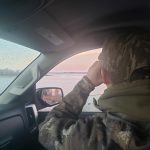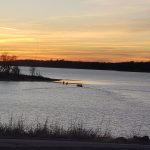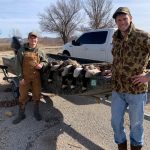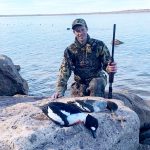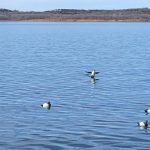Most out of state trips require months of planning and booking ahead, but as I loaded my hunting gear into the back of Ryan Stephens’ truck, I was still unsure of our destination.
Ryan chose Oklahoma as our destination even though that was subject to change over the course of our 18-hour drive. We started our drive at 12:30 a.m. on December 26th and would return on December 31st.
Much discussion had gone into this moment but until recently, it was all speculation because we didn’t know how the weather would affect the duck migration.
Our first struggle was realized before we reached our hotel in Bartlesville, OK. The Arctic cold front that pushed through at Christmas left all the ponds and most lakes frozen solid.
The next morning, Cole Gasque and Daniel Camp drove north to scout while Ryan and I continued west towards Ponca City. Daniel reported that the lakes were frozen.
Ryan and I saw one lake that was also frozen and then reached Kaw Lake, where we would end up making our stand for the next four days. The water was open, the boat ramp was empty, and the ducks were flying.
We hunted from a point on Kaw Lake for the first day and became aware of our second struggle. The water was so low that there was 40 yards of dry land between our hiding spot in the bushes and our decoys. We were going to have to make longer shots to hit the ducks when they were over our decoys.
Ryan blew the mallard call and was able to draw in three groups of mallards to our decoys. We could see them flying in from a distance, from a black speck to having color, and it tested us to wait and hold still until the perfect moment.
As one group, the mallards coasted from side to side, then fluttered their wings over our decoys and we opened fire.
Ryan dropped a mallard, missed the next, and saw his first taking off again and shot it a second time, and I completely missed.
We shot other ducks along the way like red breasted merganser, ringneck, bufflehead, and two more mallards.
Sheets of ice were pushing our decoys into deeper water, and I constantly had to fetch decoys and put them back in place.
A ringneck coasted in from the corner of my eye he skipped across the water after I shot him.
“Where has that been all day?,” Ryan asked, mocking me for missing the mallards. We returned to the hotel where we would microwave chicken bog and watch college football bowl games for the evening.
We returned to the same point on the second morning.
This time we used our layout blinds to hide on the bare sand as close to the water as possible.
Ryan and I drug every stick and log out of the woods to add some natural brush around our blinds, and we crawled inside to wait for shooting time.
Daniel and Cole went farther down the bank to the next cove.
The mallards quickly caught a glance at our decoys and came one at a time.
Ryan shot the first two singles. A pair soon coasted in, and Ryan and I shot both ducks down.
We could see ducks in the distance flying into the cove that Daniel and Cole were in and hear them rip off a few gun shots. As the sun came up, the ducks were able to see our hiding spot better and never came back in range, so we packed up and were back at the truck by 9:30 with a group total of nine mallards and two hen golden eye. The rest of the day would be dedicated to scouting.
Ryan and I found thousands of ducks and geese at the north end of the lake and resolved to hunt there the following morning. That night, after a meal of chicken bog in the hotel microwave, we were in the parking lot cutting prairie grass and fastening it to our layout blinds to make sure we would blend in.
We set all four blinds in a row, in the middle of a patch of prairie grass and settled in before sunrise. The birds started flying and a group of Gadwal came in out of which we shot down five. The mallards were wary of us and wanted to land in our decoys, but they could tell something wasn’t right. They kept their distance, and we had to break out of the blinds to make long shots on one group, managing to shoot three down.
Geese were constantly flying over and landing on the ice in the middle of the lake. Ryan called for every group of geese, but they all ignored us except for one group. A group of Canadian Geese broke from the formation and came straight for our decoys. Ryan yelled, “Shoot ‘em!,” and we popped out of our blinds shooting down five geese. Another group of geese flew overhead, and I shot a Speckled Belly Goose out of the group.
We cleaned our ducks at the parking lot and made PB&J sandwiches before we split to do some scouting. Ryan asked if I wanted to go scouting for the Golden Eye, a diver duck found in the open water. We launched the john boat and stopped at a rocky point on the lake to observe. I shot down a Ringneck that was flying by, but we did not see any Goldeneye. It was getting late, and we could see a frontal fog developing over the lake. By the time we reached the ramp, a dense fog covered the lake and the air had significantly cooled again. We returned to the hotel to microwave a chicken bog and make plans for the next day.
Daniel and Cole returned to the same spot as the day before and set up their layout blinds. Ryan and I took his John boat and tried to reach the other side of the lake where we saw lots of birds landing the day before. Everything was going according to plan until we heard ice crunching under the boat. The whole lake was frozen, and we pushed through for a while but decided to turn around while we can. We relocated to a rocky point on the side of the lake and dedicated the day to killing the Goldeneye. “We’re hunting for a unicorn today!,” Ryan said, “We only need that one drake Goldeneye.”
Ryan and I placed a few Ringneck decoys in the water because they have the same black and white colors as the Goldeneye. We climbed into our hiding spot in the rocks and waited.
Drawn in by out decoys, the Goldeneye would buzz past us, never stopping to land. We had to make long shots on low-flying birds and even though we lead the target, we could still see our shot hitting the water behind the duck. In the process, Ryan shot down a drake Bufflehead, and we both also shot a Hen Goldeneye. With a limit of two Goldeneye per person, we had to make sure our next was a drake Goldeneye.
A boat started fishing on the side of the lake near our point, and all duck activity ceased. Ryan and I relocated to a steep rock formation along the side of the lake. We hid in the rocks for about an hour before we saw our first Goldeneye fly past. Ryan missed the first one but was ready when the next came about 30 minutes later. Ryan raised his gun and fired, folding the Goldeneye. Unlike the other ducks of the day, this one did not require a 30-minute cat and mouse chase on the boat to recover the duck. Ryan was elated when he picked up his duck and I walked over to help him pull the boat back into the rocky hiding spot. At that moment, I heard whistling wings overhead, and I raised my gun to see a flock of Goldeneyes passing overhead. I picked a drake and fired two shots. The duck splashed down behind us, and I pointed my gun at the splash to finish him, but he had already dove. Ryan and I pushed out and drove to the crash site. The duck came up for air and I shot at him, but he had already dove again. We drove the boat to the last spot seen and waited. I had the gun raised and we both looked in each direction; the bird came up right in line of my sights and I fired. We recovered the duck, and both had won on an extraordinary diver duck hunt.
Idling back into our hiding spot, we were shocked to see ducks fluttering into our decoy spread, swimming and calling to each other. They took off when the boat coasted into the rocks, and we stepped back into our hiding spot. We had our limit and now were just watching an airshow. The Goldeneye were flying in and landing in our decoys. We just sat watching them. It was amazing how hard it was to get a shot at one earlier and now they were all around us. We packed our decoys and rode back to the boat ramp.
We packed the drake Goldeneyes to preserve them for a taxidermist, and we put the truck in drive to make our non-stop return home.
This trip was the first of its kind for me and it was a great learning experience to learn the strategy involved in finding and calling in mallards and shooting new species. Even for Ryan, who had been on western duck hunting trips before and planned this one, was put to the test facing new circumstances and was able to put the group on exciting hunts.
The most important thing for public land hunting is to scout and to have a plan for the coming hunt. We could have killed more ducks with an outfitter, but a successful hunt is more than shooting ducks and the planning and scouting involved made our success even more meaningful.
PHOTO GALLERY


